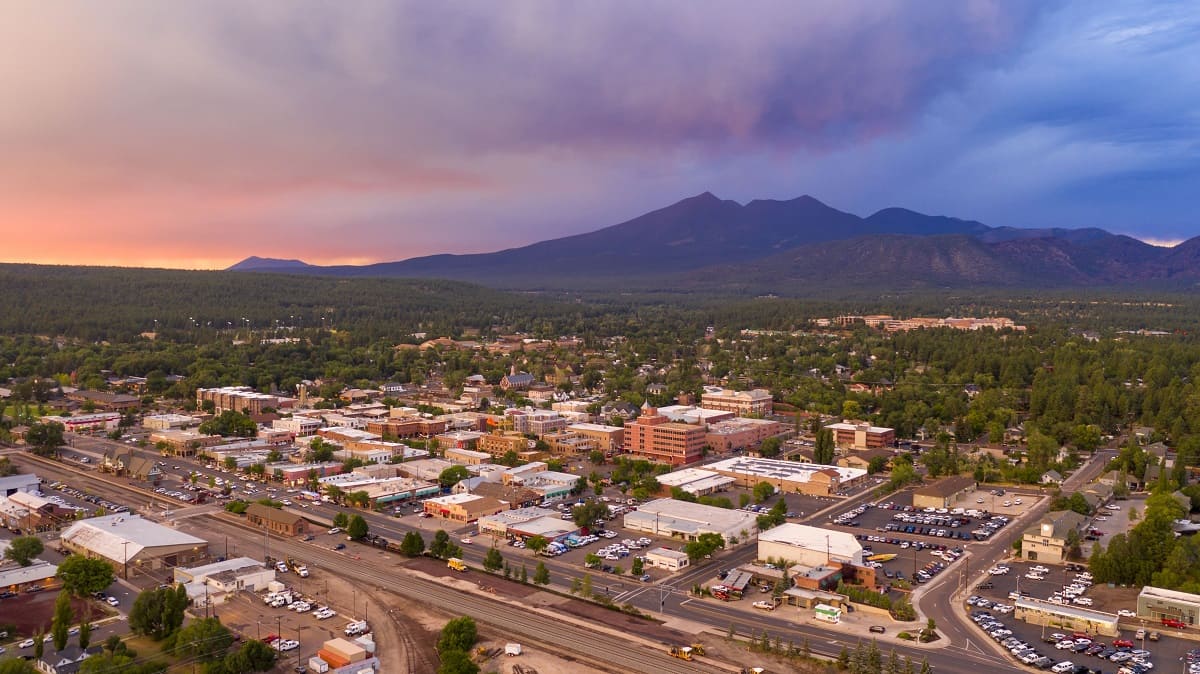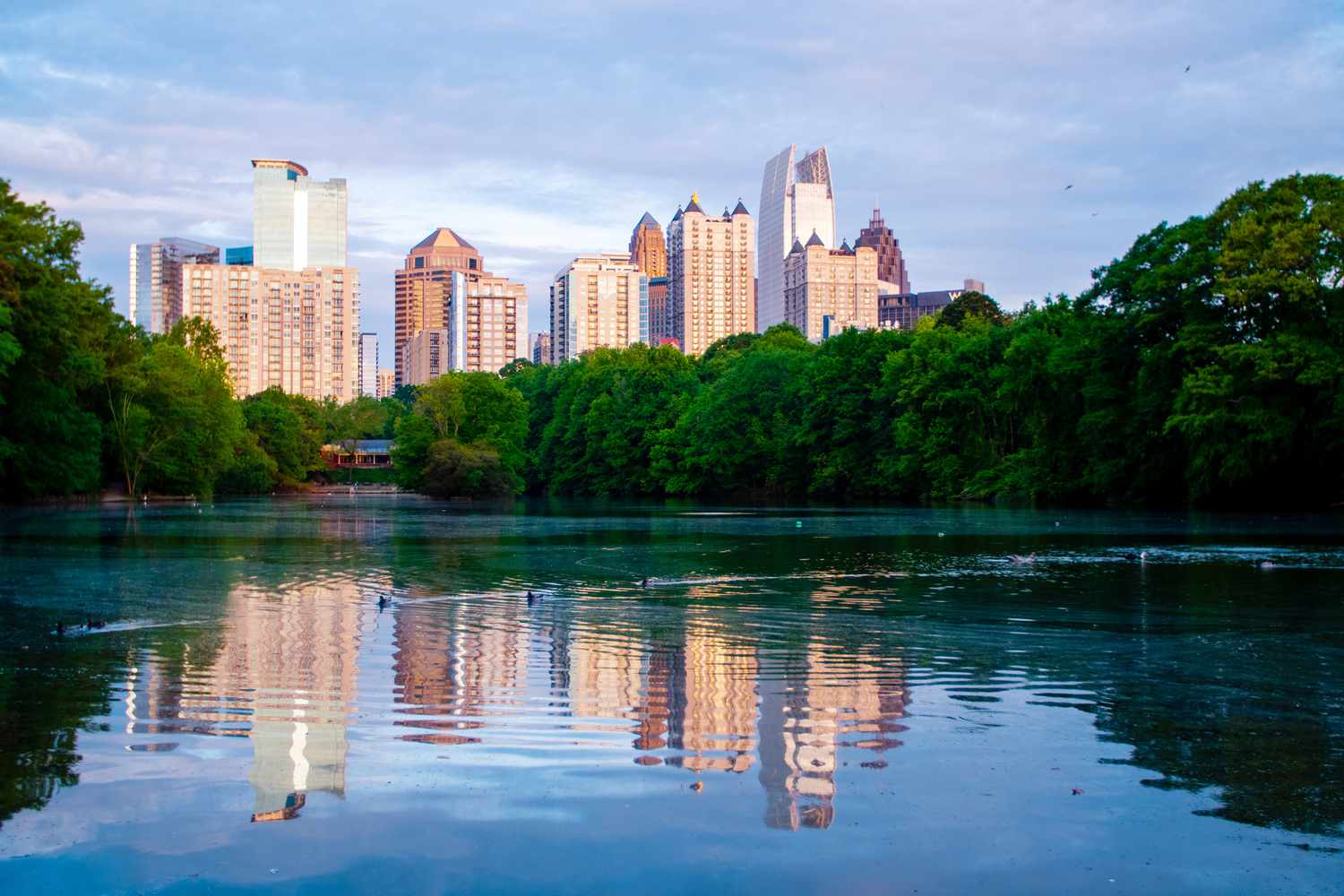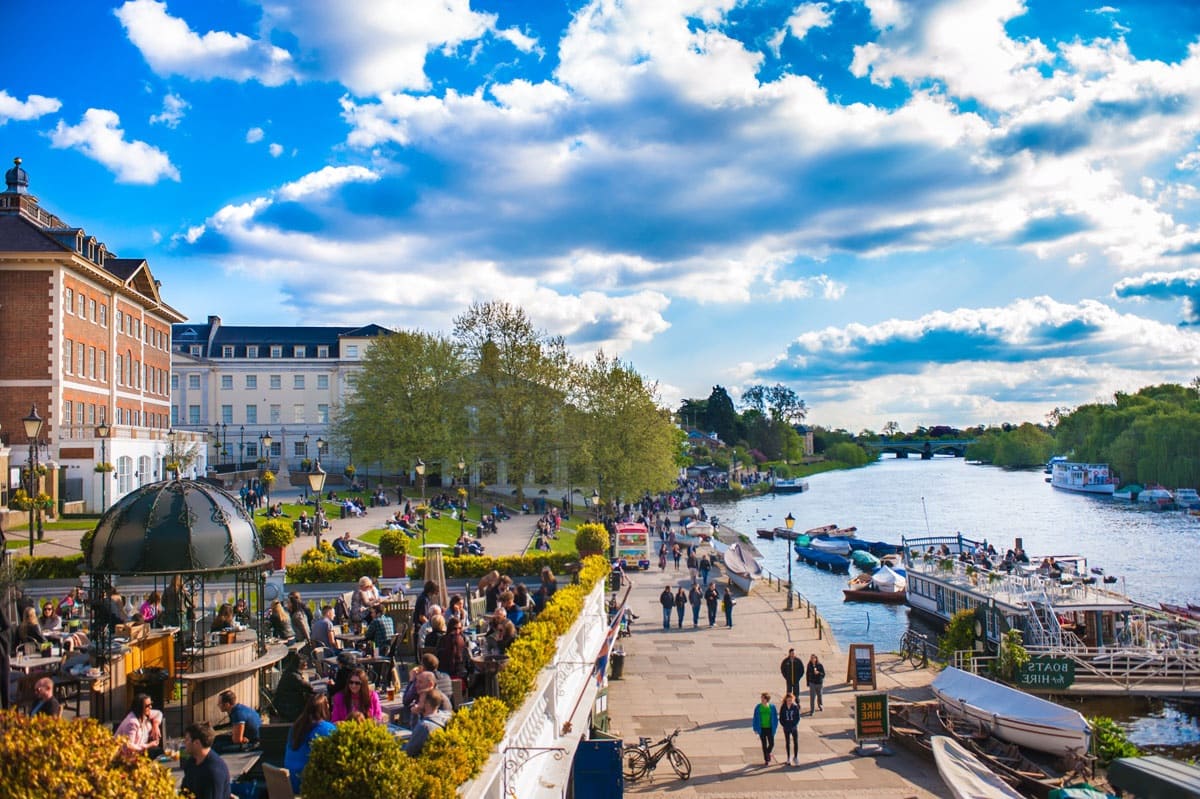Home>Weather and Climate>Average Temperature In Flagstaff, Arizona: Climate And Weather Information


Weather and Climate
Average Temperature In Flagstaff, Arizona: Climate And Weather Information
Published: February 29, 2024
Discover the average temperature in Flagstaff, Arizona, and get detailed weather and climate information to plan your visit. Explore the climate and weather patterns of this scenic city.
(Many of the links in this article redirect to a specific reviewed product. Your purchase of these products through affiliate links helps to generate commission for Temperatures.com, at no extra cost. Learn more)
Table of Contents
Introduction
Flagstaff, Arizona, is a city renowned for its stunning natural beauty, diverse landscapes, and unique climate. Nestled in the high country of northern Arizona, Flagstaff is a place where the desert meets the mountains, creating a captivating environment that draws in visitors and residents alike. The city's climate and weather patterns play a significant role in shaping the experiences of those who live in or visit this vibrant community.
Understanding the average temperature in Flagstaff is crucial for comprehending the region's climate and its impact on daily life, outdoor activities, and the local ecosystem. From the scorching heat of summer to the serene snowfall of winter, Flagstaff's temperature variations contribute to the city's distinct character and appeal.
In this article, we will delve into the geography, climate, and weather patterns of Flagstaff, Arizona, to gain a comprehensive understanding of the factors that influence the city's average temperature. By exploring the interplay of geographical features, atmospheric conditions, and seasonal changes, we can unravel the complexities that give rise to Flagstaff's unique temperature profile. Let's embark on a journey to uncover the intricacies of Flagstaff's average temperature and gain a deeper appreciation for the dynamic forces that shape this captivating region.
Read more: Average Monthly Temperatures In Arizona
Geography of Flagstaff, Arizona
Flagstaff, Arizona, is situated in the northern part of the state, approximately 140 miles north of Phoenix. Nestled within the Coconino National Forest, the city is surrounded by the San Francisco Peaks, a volcanic mountain range that includes the state's highest peak, Humphreys Peak, standing at an impressive 12,633 feet. This prominent geological feature not only contributes to the city's breathtaking skyline but also significantly influences its climate and weather patterns.
The region's high elevation, averaging around 7,000 feet above sea level, distinguishes Flagstaff from many other Arizona cities, resulting in a markedly different climate. The city's location on the Colorado Plateau also plays a pivotal role in shaping its geography, as it is positioned between the desert lowlands to the south and the vast Colorado Plateau to the north and east.
Flagstaff's unique geography gives rise to diverse ecosystems, including ponderosa pine forests, alpine tundra, and high desert terrain. The city's proximity to the Grand Canyon, approximately 80 miles to the northwest, further accentuates its remarkable geographical setting. The Colorado River, a lifeline for the arid Southwest, flows through the Grand Canyon, impacting the overall moisture levels and weather patterns in the region.
The presence of the San Francisco Peaks not only contributes to the city's stunning natural scenery but also influences local weather phenomena. The mountains act as a barrier, impacting precipitation patterns and creating a rain shadow effect on the city's leeward side. This geographical feature contributes to the distinct microclimates found within and around Flagstaff, adding to the area's ecological richness and climatic diversity.
In summary, Flagstaff's geography is characterized by its high elevation, proximity to the San Francisco Peaks, and its position within the diverse landscapes of the Colorado Plateau. These geographical elements collectively shape the city's climate and weather patterns, laying the foundation for the unique temperature variations experienced in this captivating region.
Climate of Flagstaff
Flagstaff, Arizona, boasts a unique and diverse climate that sets it apart from the typical desert landscapes associated with the state. The city experiences a semi-arid climate with distinct seasonal variations, influenced by its high elevation and geographical features. The climate of Flagstaff is characterized by relatively mild summers, crisp autumns, snowy winters, and refreshing springs, offering a rich tapestry of weather experiences throughout the year.
During the summer months, Flagstaff enjoys moderate temperatures, with average highs ranging from the mid-70s to low 80s Fahrenheit. The city's elevation contributes to cooler temperatures compared to the scorching heat experienced in other parts of Arizona. This pleasant summer climate attracts outdoor enthusiasts seeking relief from the sweltering conditions prevalent in lower elevations. Additionally, the monsoon season, typically occurring from July to September, brings intermittent thunderstorms and localized downpours, adding a dramatic element to the summer weather.
As autumn unfolds, Flagstaff undergoes a breathtaking transformation as the surrounding forests and landscapes are adorned with vibrant hues of gold, crimson, and amber. The crisp air and clear skies create an idyllic setting for outdoor activities, making it a favored season for hiking, camping, and enjoying the natural splendor of the region.
Winter in Flagstaff is a magical time characterized by snow-covered landscapes and a serene ambiance. The city receives a generous amount of snowfall, transforming it into a winter wonderland that attracts skiers, snowboarders, and winter enthusiasts. The average snowfall in Flagstaff ranges from 100 to 120 inches, providing ample opportunities for snow-based recreation and creating a picturesque backdrop for seasonal festivities.
As spring emerges, Flagstaff experiences a gradual thaw, with blooming wildflowers and rejuvenated landscapes signaling the arrival of milder temperatures. The city's surroundings come alive with renewed vitality, offering a delightful transition from the winter chill to the warmth of spring.
The unique climate of Flagstaff, shaped by its elevation, geographical setting, and seasonal dynamics, contributes to the city's allure as a year-round destination for nature lovers, outdoor adventurers, and those seeking a diverse and captivating climate experience. This distinctive climate sets the stage for the exploration of Flagstaff's average temperature and the factors that influence its fluctuation throughout the year.
Weather Patterns in Flagstaff
Flagstaff, Arizona, experiences a fascinating array of weather patterns throughout the year, reflecting the city's unique climate and geographical influences. The interplay of elevation, proximity to mountain ranges, and regional atmospheric dynamics gives rise to diverse and captivating weather phenomena that contribute to the city's distinct character.
During the summer months, Flagstaff encounters relatively mild and pleasant weather, with occasional afternoon thunderstorms punctuating the clear blue skies. These localized thunderstorms, often accompanied by dramatic lightning displays and brief, intense downpours, add an element of excitement to the summer weather. The monsoon season, typically from July to September, brings a surge of moisture to the region, contributing to the rejuvenation of the surrounding landscapes and the replenishment of water sources.
As autumn unfolds, Flagstaff undergoes a remarkable transition, marked by crisp, cool air and the gradual transformation of the surrounding foliage into a vibrant tapestry of autumnal colors. The city's weather patterns during this season create an inviting atmosphere for outdoor activities, such as hiking, leaf-peeping, and enjoying the natural splendor of the region.
Winter in Flagstaff is characterized by abundant snowfall, transforming the city into a winter wonderland. The surrounding mountains and forests are blanketed in snow, creating a picturesque setting for winter sports and seasonal festivities. The city's weather patterns during winter contribute to a thriving winter recreation industry, drawing in visitors eager to experience the magic of snow-covered landscapes and the exhilaration of cold-weather activities.
As spring emerges, Flagstaff experiences a gradual transition from the winter chill to milder temperatures. The city's weather patterns during this season bring about the awakening of nature, with blooming wildflowers and the return of vibrant greenery signaling the arrival of spring. The rejuvenation of the landscapes, coupled with the pleasant weather, sets the stage for outdoor exploration and the appreciation of the region's natural beauty.
In summary, Flagstaff's weather patterns encompass a diverse range of seasonal experiences, from the dramatic monsoon storms of summer to the tranquil snowfall of winter and the vibrant renewal of spring. These weather patterns, influenced by the city's unique climate and geographical features, contribute to the rich tapestry of experiences that define Flagstaff's captivating weather dynamics.
Average Temperature in Flagstaff
Flagstaff, Arizona, experiences a wide range of average temperatures throughout the year, reflecting the city's unique climate and geographical characteristics. The city's high elevation, averaging around 7,000 feet above sea level, significantly influences its temperature profile, leading to distinct seasonal variations and creating a diverse tapestry of weather experiences.
During the summer months, Flagstaff enjoys relatively mild average temperatures, with daytime highs typically ranging from the mid-70s to low 80s Fahrenheit. The refreshing mountain air and lower temperatures compared to the scorching heat of lower elevations make Flagstaff an inviting escape for those seeking relief from the summer heat. The city's average summer temperature creates an ideal environment for outdoor activities, such as hiking, mountain biking, and exploring the surrounding natural landscapes.
As autumn unfolds, Flagstaff experiences a gradual cooling, leading to a delightful transition marked by crisp mornings and comfortable daytime temperatures. The average temperature during this season ranges from the mid-50s to low 60s Fahrenheit, creating an inviting atmosphere for leaf-peeping, outdoor festivals, and enjoying the stunning fall foliage that blankets the region.
Winter in Flagstaff brings a significant drop in average temperatures, with daytime highs ranging from the mid-30s to low 40s Fahrenheit. The city receives a generous amount of snowfall, contributing to the transformation of the surrounding landscapes into a winter wonderland. The average winter temperature, coupled with the picturesque snowy scenery, sets the stage for a thriving winter recreation industry, attracting snow enthusiasts and visitors eager to experience the magic of a snowy wonderland.
Spring in Flagstaff marks a gradual warming trend, with average temperatures ranging from the mid-50s to low 60s Fahrenheit. The city's surroundings come alive with the vibrant colors of blooming wildflowers and the rejuvenation of the natural landscapes, offering a delightful transition from the winter chill to the warmth of spring.
In summary, Flagstaff's average temperature varies significantly across the seasons, contributing to the city's diverse climate experiences. The interplay of high elevation, geographical setting, and seasonal dynamics shapes the average temperature in Flagstaff, creating a captivating environment that beckons visitors and residents to explore and embrace the unique weather patterns of this remarkable region.
Factors Affecting Temperature in Flagstaff
The average temperature in Flagstaff, Arizona, is influenced by a myriad of factors that collectively shape the city's unique climate and weather patterns. Understanding these influential elements provides valuable insight into the temperature variations experienced in this captivating region.
-
Elevation: Flagstaff's high elevation, averaging around 7,000 feet above sea level, plays a pivotal role in determining its temperature profile. The city's elevated position results in cooler average temperatures compared to lower-lying areas, creating a refreshing and inviting climate, especially during the summer months. The impact of elevation on temperature is particularly pronounced, contributing to the city's distinct seasonal variations and setting it apart from the typical desert heat associated with Arizona.
-
Geographical Setting: The proximity of Flagstaff to the San Francisco Peaks, a volcanic mountain range that includes the state's highest peak, significantly influences its temperature dynamics. The mountains act as a barrier, impacting precipitation patterns and creating a rain shadow effect on the city's leeward side. This geographical feature contributes to the creation of microclimates within and around Flagstaff, leading to localized temperature variations and enhancing the city's climatic diversity.
-
Seasonal Dynamics: The seasonal transitions in Flagstaff, from the mild summers to the snowy winters and vibrant springs, are instrumental in shaping the city's average temperature. The interplay of seasonal variations, such as the monsoon season in summer and the rejuvenation of landscapes in spring, contributes to the fluctuation of average temperatures throughout the year. These seasonal dynamics add depth and richness to Flagstaff's climate, offering a diverse tapestry of weather experiences.
-
Atmospheric Conditions: The atmospheric conditions prevalent in the region, including the influence of the Colorado Plateau and the impact of the nearby Grand Canyon, contribute to the city's temperature patterns. The presence of the Colorado River, which flows through the Grand Canyon, affects moisture levels and weather phenomena, influencing the overall temperature dynamics in the area. Additionally, the city's semi-arid climate, characterized by relatively low precipitation, further shapes its temperature profile.
-
Urban Heat Island Effect: While Flagstaff is renowned for its natural beauty and diverse landscapes, the urban heat island effect, commonly observed in developed areas, can also influence local temperature patterns. As the city continues to grow and urbanize, the impact of this phenomenon on temperature dynamics becomes increasingly relevant, highlighting the need for sustainable urban planning and environmental stewardship.
In summary, the average temperature in Flagstaff is influenced by a combination of factors, including elevation, geographical setting, seasonal dynamics, atmospheric conditions, and the urban heat island effect. These elements collectively contribute to the city's unique climate and weather patterns, shaping the temperature variations experienced throughout the year and adding to the allure of this remarkable region.
Conclusion
In conclusion, the average temperature in Flagstaff, Arizona, reflects the intricate interplay of geographical, climatic, and seasonal dynamics that collectively shape the city's unique temperature profile. The city's high elevation, averaging around 7,000 feet above sea level, contributes to cooler average temperatures compared to lower-lying areas, creating a refreshing and inviting climate that sets Flagstaff apart from the typical desert heat associated with Arizona. This elevation-driven influence on temperature is particularly pronounced, leading to distinct seasonal variations and enhancing the city's climatic diversity.
The geographical setting of Flagstaff, nestled within the Coconino National Forest and in close proximity to the San Francisco Peaks, significantly impacts its temperature dynamics. The presence of the volcanic mountain range creates diverse microclimates within and around the city, leading to localized temperature variations and enriching the region's climatic tapestry. Additionally, the seasonal transitions, from the mild summers to the snowy winters and vibrant springs, play a pivotal role in shaping the city's average temperature, offering a diverse range of weather experiences throughout the year.
Atmospheric conditions, including the influence of the Colorado Plateau and the impact of the nearby Grand Canyon, further contribute to Flagstaff's temperature patterns. The presence of the Colorado River, which flows through the Grand Canyon, affects moisture levels and weather phenomena, influencing the overall temperature dynamics in the area. Moreover, the city's semi-arid climate, characterized by relatively low precipitation, adds to the complexity of its temperature profile.
As Flagstaff continues to evolve and urbanize, the urban heat island effect becomes increasingly relevant, potentially influencing local temperature patterns. Sustainable urban planning and environmental stewardship will play a crucial role in mitigating the impact of this phenomenon, ensuring the preservation of Flagstaff's unique climate and temperature dynamics.
In essence, the average temperature in Flagstaff is a product of its geographical features, climatic characteristics, seasonal transitions, and the influence of atmospheric conditions. This captivating interplay of factors contributes to the city's allure as a year-round destination for nature lovers, outdoor enthusiasts, and those seeking a diverse and captivating climate experience. By unraveling the complexities of Flagstaff's average temperature, we gain a deeper appreciation for the dynamic forces that shape this remarkable region, inviting visitors and residents to embrace and explore the rich tapestry of weather experiences that define Flagstaff, Arizona.














